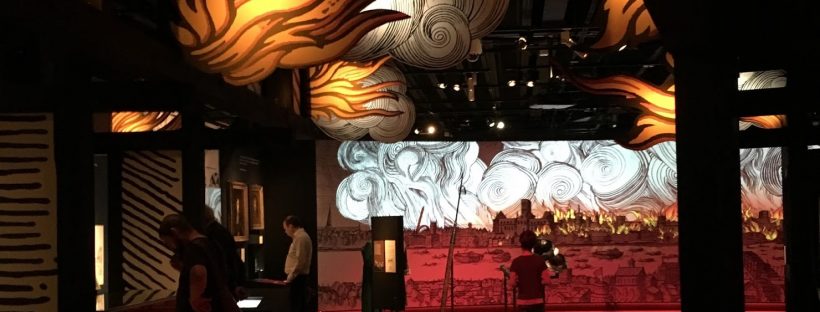350 years ago London was devastated by the The Great Fire of London. Fires were commonplace in London as the city was full of wooden buildings on narrow streets, but this one was a disaster of major proportions when 13,200 houses and 87 churches were destroyed and around 100,000 people were made homeless.
The Museum of London has a great exhibition called Fire! Fire! which takes you through the 5 days of the fire and its aftermath through quotes from those caught up in the fire, original objects, paintings, interactive displays, films and original illustrations, all with the sounds of fire in the background.

Welcome to the exhibition!
Welcome to the exhibition!
It all started early in the morning of 2nd September 1666 when Thomas Farriner, a baker living in Pudding Lane, woke on this Sunday morning to a fire in his downstairs bakery. He escaped with his family and their neighbours helped to try to put the flames out. However, London was dry after a period of drought and the winds were picking up from the east so the fire began to spread.
Samuel Pepys the famous diarist of the age was woken with news of the fire and soon realised it was serious so he went to see the King. A wonderful timeline takes us through the events of the next 5 days. Pepys had a great deal of foresight and here, in one of the many wonderful quotes that bring this exhibition to life, he warns the King of the dangers ahead.

Follow the fire hour by hour on the timeline

Pepys is off to see the King on 2nd September
Next, we see a large block shaped like a loaf graphically showing the fire spreading through a map of the city, blotting out in streets and homes as it goes.

A small black area on the morning of 2nd September

4 days later, the city has burned to its edges
As the fire takes hold on the 3rd of September we see dramatic painting showing flames engulfing everything, both by unknown artists. The sounds effects get loader and the quotes more concerned!



As the flames gather strength people are grabbing what they can and even treasured items are caught in the fire before they are rescued.


The burnt edges of a family bible.
The main exhibition room is well designed to add to the atmosphere:

Valiant efforts to extinguish the fire ranged from huge fire poles to pull down buildings, fire squirts (like a big metal syringe), very small buckets filled with water and gunpowder used to create fire breaks to halt the spread of the fire. An interactive game gives you the chance to try these different methods and see which works best.

Interactive firefighting game!

Fire buckets far to small for the job

Fire buckets in use, but fairly useless!

Firepole

Fire squirt
The King, Charles ll, and his brother were busy helping the fight, having travelled from Whitehall into the scene of the fire – perhaps he had learned from his father’s death that he needed to be seen to be involved in the people’s problems!

Luckily, the winds died down, changed direction and the fire-fighting efforts began to pay off and on Wednesday the fire was conquered, with that man Samuel Pepys in the thick of the action again on the Thursday, claiming the last fire! Embers must have burned for days and can you imagine the smell of charred London?

About a quarter of London was in ruins after the fire and tens of thousands of people were living in temporary camps, tents and sheds on the hills around the city. The King sent money to buy them bread but their situation must have been desperate. Thoughts turned to how to rebuild this great city. Firstly, however, the blame game started and the ‘usual suspects’ were under suspicion: Catholics, and foreigners, particularly the French and the Dutch. Or was it an act of an angry God? Sinful Londoners perhaps brought it on themselves? Pie Corner is a memorial to that theory.

The inevitable crime wave followed and the King intervened to legislate that items stolen should be returned and we can read his proclamation against ‘imbezzell’d’ goods:

The good news was that surprisingly few people died, officially fewer than 10 but it is thought that many others have died and been buried in burned-out buildings as record keeping was not good back then.
We learn about the rebuilding plans, including information that Sir Christopher Wren had, rather amazingly, completed a plan ready to show the King just 6 days after the fire. Now, that seems a bit quick to me or am I being too suspicious? Much of the planned schemes did not happen as there was not enough money and the decisions took too long, so the new city grew up mostly around the old street layout albeit with wider roads in many places to reduce the fire risk. It took about 40 years for a new, largely brick city to emerge including a brand new St Paul’s cathedral thanks to Wren. London was ready to face its future:

One fun game before you leave, lets you design your own version of London after the Great Fire using a range of wooden blocks:

Build your own London
For full information about opening hours and ticket prices check the Museum of London’s website
Disclosure: As is customary in this industry, I was offered a complimentary ticket to see this exhibition. This has not influenced what I have said and I would happily pay my own money to see this show.
